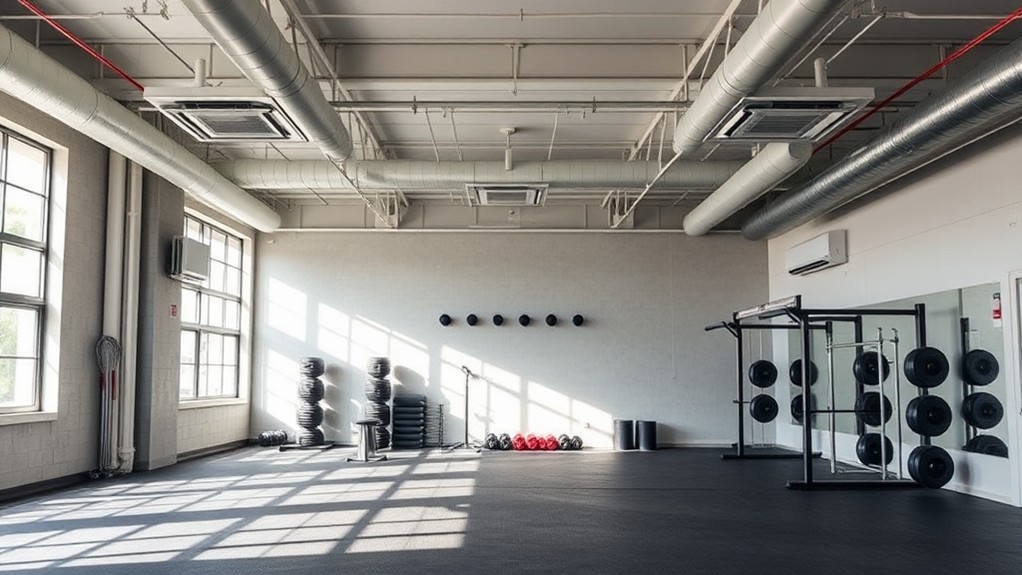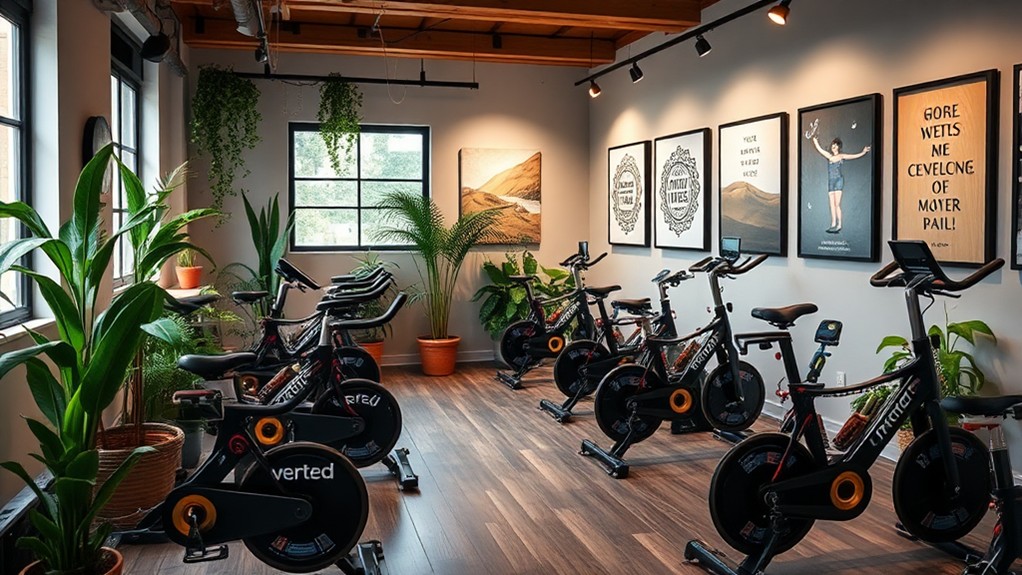Creating a personalized indoor training space takes some thoughtful planning, but the rewards are immense. Start by selecting a minimum 4×8 foot area with hard, level flooring and convenient electrical outlets. Non-slip, padded mats will protect your joints and equipment. Crucial gear includes a high-quality stationary bike or trainer, plus accessories like fans, water bottle holders, and heart rate monitors. Verify proper bike fit for optimal performance and comfort. Integrate smart technology like fitness apps and wireless trainers to track your progress. Maintain a comfortable, clutter-free environment with proper ventilation, lighting, and personalized decor. Establishing a consistent training routine and incorporating rest days will prevent burnout. Ready to take your indoor cycling to the next level?
Space Selection and Preparation
Designating an appropriate space is vital when creating your permanent indoor training setup. Aim for a floor area of at least 4 feet wide by 8 feet long to accommodate your equipment and movements comfortably.
Choose a hard, level surface like a spare room or garage floor, as this will provide the stability needed to support your gear without damaging the underlying surface. Proximity to electrical outlets is critical for powering your equipment, so position the space near a wall with accessible sockets.
To enhance natural light and temperature control, set up near a window, but avoid areas close to sleeping quarters to minimize disturbances. Furthermore, consider the noise level, selecting a location free from distractions that could compromise your focus during workouts.
Once you've designated the perfect space, organize your equipment storage to keep your training area clean and clutter-free, ensuring a seamless and efficient workout experience.
Essential Equipment and Accessories
Once you've designated the perfect space, equipping your indoor training setup with important gear is imperative for an effective and comfortable workout experience. A high-quality stationary bike or turbo trainer is fundamental, with direct drive models providing accurate power measurement and a quieter ride.
Adjustable seats and handlebars guarantee a proper bike fit, enhancing performance and preventing injuries during long sessions.
Key accessories include a training mat, towel, and fan to manage sweat and control temperature. Incorporating a water bottle holder and heart rate monitor can additionally optimize hydration and track your fitness progress.
Regular maintenance, such as lubricating moving parts and cleaning components, is critical for the longevity and optimal performance of your equipment.
Whether your training goals involve improving endurance, strength, or speed, having the right bike and accessories will create a seamless indoor cycling experience tailored to your needs.
Flooring and Safety Considerations

With the right equipment in place, turning your attention to the flooring and safety considerations is key for creating a permanent indoor training setup.
Choose non-slip flooring materials like rubber or vinyl to improve safety during workouts and reduce the risk of slips and falls, especially when using equipment like indoor bikes. For added protection, use padded mats underneath the equipment to absorb impact, safeguard your joints, and minimize noise and vibrations transmitted to the floor.
Ensure the flooring can support the weight of your exercise gear, as heavy bikes or trainers can damage weaker surfaces. A hard, level floor is ideal for stability.
To maintain a peaceful environment, consider soundproofing materials to lessen noise during training sessions. Ultimately, regularly clean and maintain the flooring and mats to prevent sweat buildup and odors, keeping your training area hygienic and pleasant.
Technology Integration and Connectivity
Integrating technology into your permanent indoor training setup can greatly improve your workout experience. Utilize fitness apps like Zwift or TrainerRoad to track your progress and follow structured training plans that simulate outdoor riding.
To guarantee a seamless connection, make certain your training area has a strong WiFi signal, using range extenders if necessary to eliminate any dead spots.
Enhance your motivation and engagement by setting up a sound system or Bluetooth speakers to play your favorite music or podcasts during your workouts.
Moreover, incorporate a screen or tablet holder to easily access virtual classes, instructional videos, or cycling apps, providing visual guidance and feedback throughout your training sessions.
Invest in smart trainers that connect wirelessly to your devices, allowing you to monitor real-time performance metrics and experience interactive training that mimics outdoor gradients.
These connectivity solutions will improve your indoor cycling experience and help you reach your fitness goals.
Climate Control and Ventilation

Maintaining a comfortable and well-ventilated indoor training environment is paramount for maximizing your workout performance and enjoyment.
Utilize fans with a diameter of at least 12 inches to provide adequate airflow and keep your body temperature controlled during intense sessions. Consider installing air conditioning units or portable coolers to uphold a comfortable temperature, ideally between 68-72°F (20-22°C), for optimal training.
Monitor humidity levels, aiming for a range between 40-60% to prevent excessive sweating and discomfort during workouts, which can hinder performance.
Guarantee proper ventilation by opening windows or using exhaust fans to improve air quality and reduce the buildup of moisture and odors in the training space. Incorporate a dehumidifier if necessary to manage humidity levels, especially in basements or enclosed spaces where moisture can accumulate.
Lighting and Ambiance
Adjustable lighting is essential for creating a suitable workout environment, allowing you to tailor brightness levels to match different workout intensities and times of day, boosting focus and motivation.
Incorporating natural light into the training space can improve mood and energy levels, making your workouts feel more pleasant and less confined, thereby increasing overall workout adherence.
Consider these three tips for creating the perfect lighting setup:
- Utilize mood lighting, such as LED strips or smart bulbs, that can be programmed to shift colors during your sessions, providing visual cues for intensity changes or rest periods, which can elevate your engagement.
- Guarantee proper visibility for safety during exercises, with a minimum of 300 lux recommended for general exercise and higher levels (up to 1,000 lux) for activities requiring precise movements.
- Add mirrors not only to improve the perception of space but likewise to allow for self-monitoring of form and technique, which can boost your workout effectiveness and prevent injuries.
Personalization and Inspiration

Personalizing your indoor training setup can greatly improve motivation and engagement during your workouts. A motivational wall displaying your personal goals, achievements, and inspirational quotes or images can foster a positive training environment.
Incorporate vibrant color schemes and decor changes periodically to keep the training space new and energizing, improving focus and motivation.
Strategically placed mirrors can create an illusion of a larger space while likewise allowing for self-assessment during workouts, refining form and technique.
Personalize the area with memorabilia related to your cycling experience, such as race bibs, medals, or posters of favorite cyclists, to evoke a sense of pride and motivation.
Regularly update your visible training plans or schedules on a bulletin board to maintain accountability and encourage progress tracking.
Goal visualization and motivational quotes can be powerful tools to elevate your drive and resilience during challenging training sessions.
Establishing a Consistent Routine
To build a sustainable indoor training habit, establish a consistent workout schedule by setting specific days and times for your sessions. Aim for at least three to five sessions per week to create a strong routine and maintain momentum.
When structuring your schedule, incorporate a variety of exercises to prevent boredom and promote comprehensive fitness:
- Incorporate cycling, strength training, and flexibility work to challenge your body in different ways.
- Use fitness apps to set measurable goals, track progress, and adjust your plan as needed, keeping you motivated and engaged.
- Include regular rest and recovery days to allow for muscle repair and prevent burnout, essential for long-term success and injury prevention.
Reassess your training plan every few weeks to adapt to changing fitness levels, goals, or interests, ensuring your routine remains invigorating and aligned with your progress.
Consistency, variety, and adaptability are the keys to forming a lasting indoor training habit.
Entertainment and Focused Training

Enhancing your indoor training experience is crucial for maintaining motivation and focus. Incorporating a sound system or Bluetooth speakers can liven up your workouts by playing high-tempo playlists or motivational tracks, making your sessions more enjoyable and engaging.
Utilizing fitness apps like Zwift or TrainerRoad can provide structured training plans and real-time performance metrics, keeping you focused and motivated during your indoor cycling sessions.
To reduce distractions, set up a designated screen or tablet holder for easy access to instructional videos or entertainment. Listening to podcasts or audiobooks can likewise provide an entertaining distraction, making the time spent training feel shorter and more productive.
Ensuring your training area is free from external noise and clutter can greatly improve your focus and workout effectiveness, leading to better performance outcomes.
Proper Bike Fit and Maintenance
A professional bike fit is vital to guarantee optimal comfort and performance during your indoor training sessions. Regularly checking and adjusting your bike fit is important, especially after significant changes in fitness level or flexibility, to prevent discomfort and injuries.
To confirm proper leg positioning, the saddle height should allow for a slight bend in the knee at the bottom of the pedal stroke, typically set at approximately 25-30 degrees of leg extension. This will help you maintain efficient pedal efficiency throughout your workouts.
Moreover, regular maintenance of your bike components, such as cleaning and lubricating the chain, can prolong the lifespan of your drivetrain parts and guarantee smooth operation.
In addition, using a towel over the handlebars during sessions can minimize sweat accumulation, reducing the risk of corrosion and wear over time.
Frequently Asked Questions
How Much Space Do You Need for a Turbo Trainer?
You'll need at least 4 feet wide by 8 feet long to set up your turbo trainer. Consider the space for ventilation, power outlets, and reducing noise and distractions during your workouts.
How to Start Indoor Bike Training?
To start indoor bike training, find a dedicated 4×8 foot space, get a smart trainer, and use fitness apps like Zwift for structured plans. You'll enjoy the training benefits of indoor cycling all year round.
How to Set up a Stationary Bike Trainer?
Choose a direct-drive or wheel-on bike trainer to enjoy indoor cycling's benefits. Set up your trainer in a dedicated space, add a riser block, and use crucial accessories like a towel and fan for a comfortable workout.
Can You Use a Gravel Bike on a Trainer?
You can use your gravel bike on a trainer to enjoy the benefits of indoor training. Just verify its compatibility with the trainer and set it up properly to maintain your gravel bike's performance.
